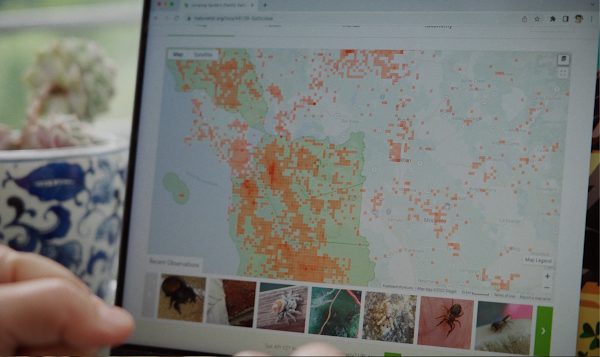Our ecological system is made up of countless species that have evolved over millions of years, and the impacts of habitat loss and climate change are the loss of species every year. iNaturalist is a crowdsourced biodiversity recording platform and a social network for people who love nature that was created as a tool to engage people around the world in ecology, educate them about the organisms around them, and aid scientific study and conservation efforts. It’s also a joint initiative between the California Academy of Sciences and National Geographic Society.
“I think it’s vital that people pay attention to other organisms,” says iNaturalist co-director, naturalist, and software engineer Ken-ichi Ueda. “We need to take care of them and think about our impact on them. Those relationships make me feel like a person. Part of what I want for iNaturalist is for more people to have those kinds of relationships.”
iNaturalist co-director and spatial ecologist Scott Loarie says that when we think about the scale of conservation challenges and how to protect species around the world, it’s key to look at species in a spatial context.
“We have to map out where these species are around the world, and how those distributions are changing,” Loarie says. “To scale the collection of biodiversity data on individual plants and animals, we need to get lots of people involved in caring about species and collecting the data we need to make good decisions.”
iNaturalist users can post photos of plants or insects they come across outside, and iNaturalist stores the photo on its servers. When other users identify the organisms, iNaturalist uses the image and identification data to train machine learning models that provide instant identifications.
iNaturalist uses Google Maps Platform in a variety of ways. The iNaturalist website is built around the Google Maps Javascript API, and the Android app is built using the Maps SDK for Android. iNaturalist makes 35 million requests to the Google Maps API every month.
“We use Google Maps Platform to show observation data, and we add layers to show all the other observations of the species that the observation depicts,” says Ueda. “We overlay our own data as separate layers on the map. We also use Google Maps Platform for geocoding services, plain and reverse, because location is central to iNaturalist. We need people to record the exact location where they saw a particular organism.”
If a user doesn’t have access to a GPS-enabled device when they’re recording an observation with iNaturalist, they can type in their location, and Google Maps Platform will return the coordinates, which iNaturalist can store. Likewise, if a user has only a GPS, and their mobile device only returns a set of coordinates, the Google Maps Platform will return the name of the place that corresponds to those coordinates, like Golden Gate Park in San Francisco.
“Conservation is a spatial problem,” says Loarie. “We’re trying to put biodiversity on the map. Once we have it on the map, we can make good decisions to keep species from extinction.”
From an environmental education perspective, being able to use the app with groups of people is valuable. Bay Area-based environmental educator Merav Vonshak uses it for citizen science initiatives called BioBlitzes, in which groups of volunteers gather together to document as many species as possible within a specific timeframe and location.
“I think iNaturalist changes the way you look at the world,” says Vonshak. “You stop in a place, and you know the specific plants and insects that live there, and it makes your experience so much richer.”
Loarie says the diversity and size of the iNaturalist community creates enormous value for individuals, scientists, and conservation.
“Scientists are realizing they can do science they could never do on their own, by interacting with lots of different people,” Loarie says. “For ordinary people, engaging with scientists makes exploration of their backyard more meaningful. iNaturalist just surpassed 120 million observations. It’s a testament to what we can do by working together on the same problem.”
For more information on Google Maps Platform, visit our website.
Cloud BlogRead More


